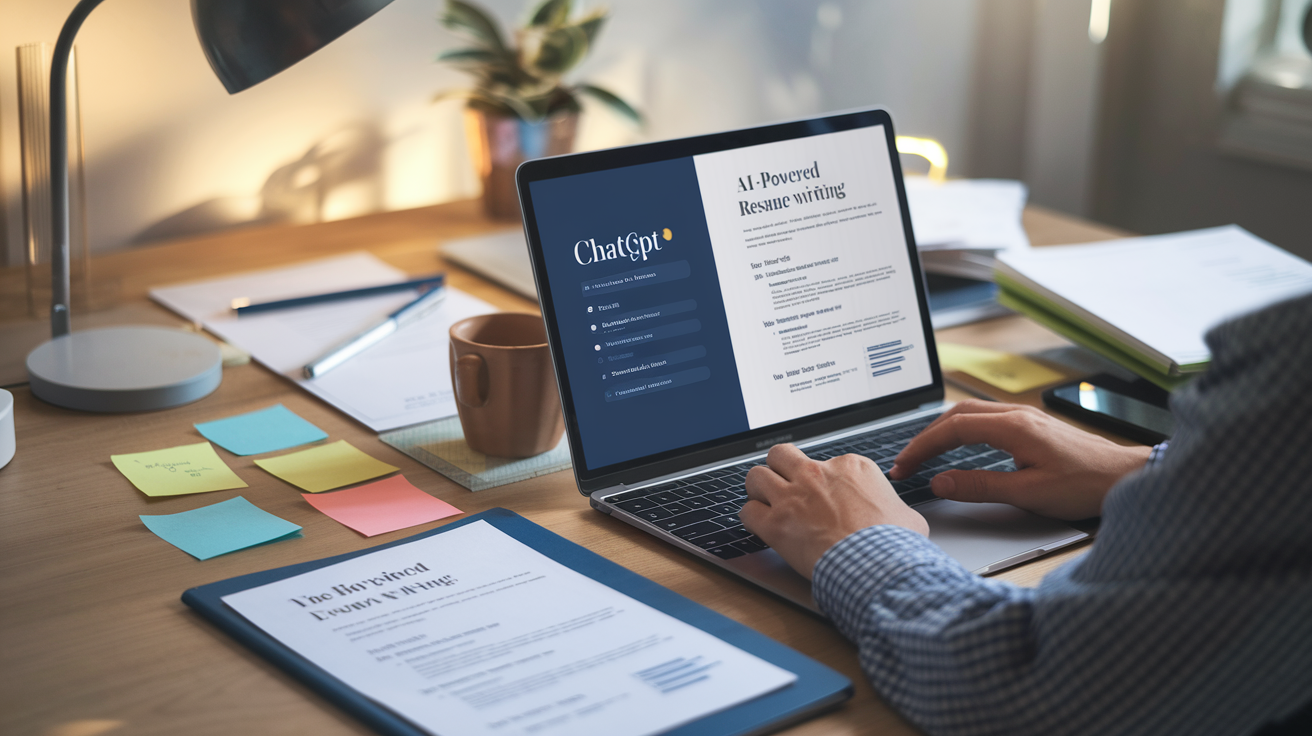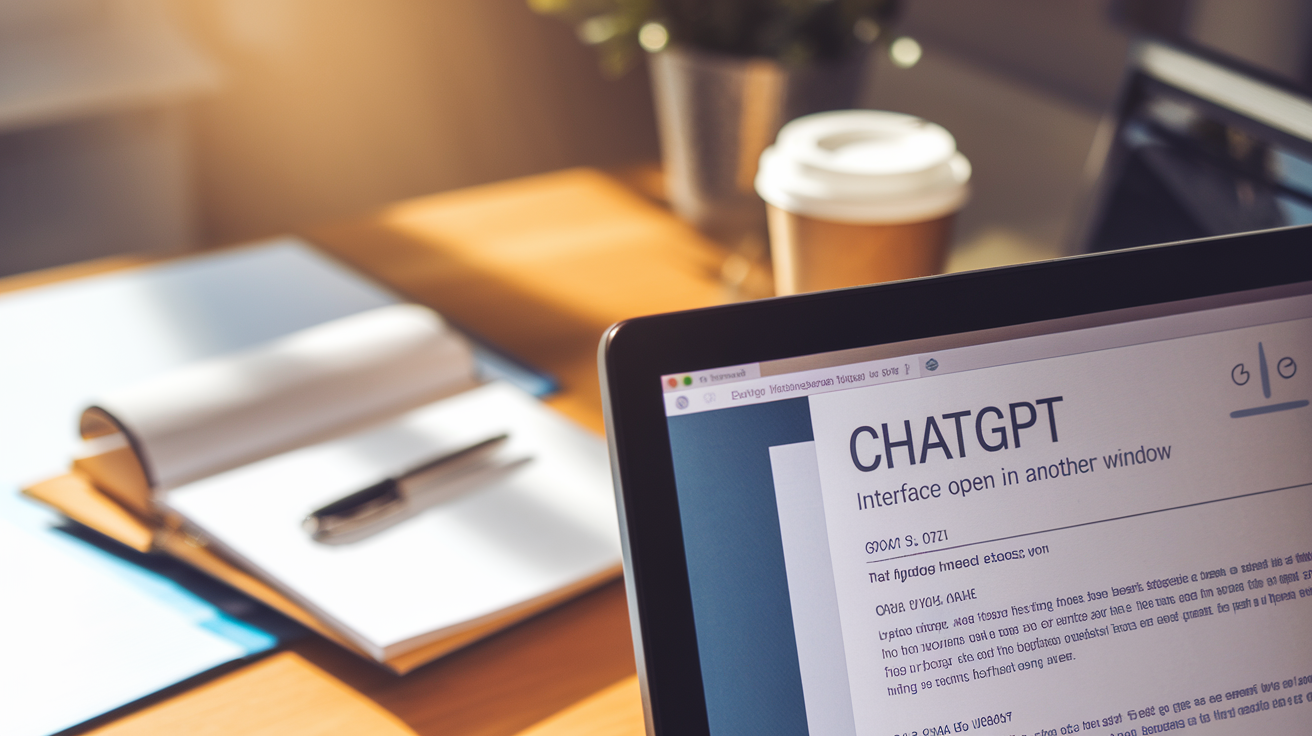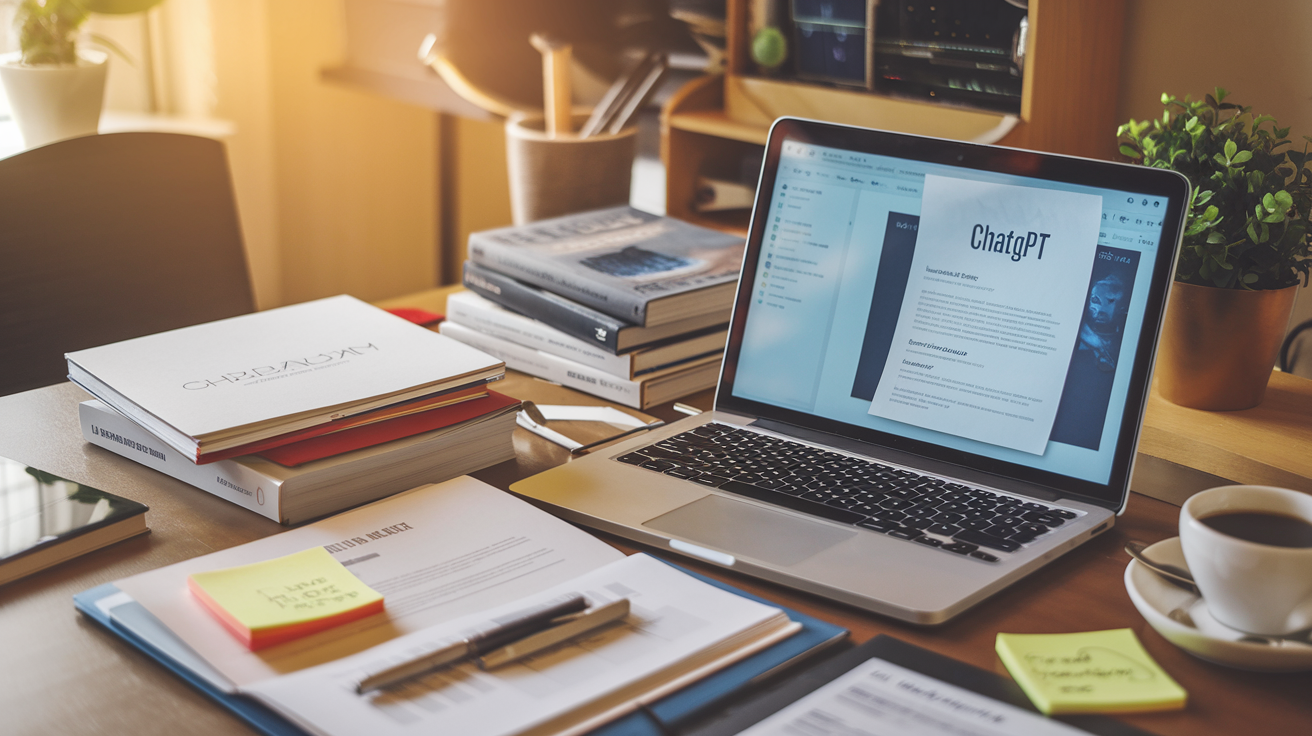
You’re staring at your resume, cursor blinking, not knowing what to change. And the clock’s ticking on that dream job application. Sound familiar?
Here’s the reality: 75% of resumes never make it past the ATS bots, let alone to a human recruiter’s desk. But what if you had an AI writing partner to help beat those odds?
Learning how to use ChatGPT for resume writing could be the difference between your application hitting the digital trash bin or landing on the “interview these candidates” pile. It’s like having a personal resume coach—minus the expensive hourly rate.
The trick isn’t just asking ChatGPT to “make my resume better.” There’s a specific way to get results that actually work. And it starts with…
Understanding ChatGPT’s Capabilities for Resume Enhancement

Understanding ChatGPT’s Capabilities for Resume Enhancement
ChatGPT has revolutionized many writing tasks, including resume creation. Before diving into specific prompts and techniques, it’s crucial to understand what this AI tool can and cannot do for your resume writing process.
What Makes ChatGPT Valuable for Resume Writing
ChatGPT excels at several aspects of resume development:
- Content generation: It can help overcome writer’s block by suggesting accomplishments, skills descriptions, and professional summaries based on your experience
- Language refinement: The AI can transform bland job descriptions into compelling achievement statements with strong action verbs
- ATS optimization: ChatGPT can help integrate relevant keywords from job descriptions to make your resume more visible to applicant tracking systems
- Formatting suggestions: While it can’t directly create visual layouts, it can provide guidance on resume structure and organization
- Customization efficiency: It dramatically reduces the time needed to tailor your resume for different positions
Many professionals find ChatGPT particularly helpful for transforming routine responsibilities into achievement-focused statements that quantify impact—a critical element of effective resumes.
Limitations to Be Aware Of
Despite its capabilities, ChatGPT has important limitations:
- Factual accuracy: ChatGPT cannot verify your work history or credentials; it can only reformat information you provide
- Industry-specific knowledge: Its understanding of niche fields may be limited or outdated
- Design limitations: It cannot produce visual resume designs or templates directly
- Personalization constraints: Without specific details from you, it may generate generic content
- Ethical considerations: Using AI-generated content that misrepresents your experience or skills is professionally inappropriate
Remember that ChatGPT functions as a collaborative tool rather than a complete solution for resume writing.
Setting Realistic Expectations
For optimal results with ChatGPT-assisted resume writing:
- Plan for multiple revisions: The first draft is rarely perfect; expect to refine and iterate
- Maintain your authentic voice: Review all suggestions to ensure they accurately represent your experience and communication style
- Provide context: The more specific information you share about your career, the more tailored the results will be
- Verify all content: Fact-check every statement before including it in your final resume
- Use as a supplement: ChatGPT works best when enhancing your own efforts, not replacing them
The most successful approach treats ChatGPT as a writing partner rather than an automated resume generator. Your knowledge, experience, and judgment remain essential to creating a resume that truly represents your professional value.
Crafting Your Resume Content with ChatGPT

Crafting Your Resume Content with ChatGPT
Writing Compelling Professional Summaries
ChatGPT excels at crafting professional summaries that capture attention. Start by providing the AI with your career highlights, years of experience, and key strengths. For example:
"Help me write a professional summary for a marketing professional with 5 years of experience specializing in digital campaigns and social media management."
For maximum effectiveness, instruct ChatGPT to keep your summary concise (3-5 sentences) and impactful. Request different versions emphasizing various strengths to find the perfect tone for your target role.
Transforming Job Descriptions into Achievement Statements
Turn mundane job duties into powerful achievement statements using ChatGPT:
- Provide your basic job responsibility
- Ask ChatGPT to reframe it with the STAR or PAR method
Example prompt:
"Transform this job description: 'Managed social media accounts' into an achievement-focused bullet point with metrics."
The AI might respond with: “Increased social media engagement by 78% across platforms through strategic content planning and community management, resulting in 15,000 new followers within six months.”
Generating Skill Lists Tailored to Job Postings
ChatGPT can help identify relevant skills by analyzing job descriptions:
"Based on this job posting [paste job description], what technical and soft skills should I highlight on my resume?"
For best results, provide ChatGPT with your existing skill set and ask it to prioritize which ones to emphasize and which new ones to consider adding based on the job requirements.
Creating ATS-Friendly Content
Applicant Tracking Systems (ATS) scan resumes before human reviewers see them. Use ChatGPT to optimize your content:
"Make this resume section ATS-friendly for a [position title] role while maintaining readability for human reviewers."
ChatGPT can help you:
- Incorporate relevant keywords naturally throughout your resume
- Suggest standard section headings recognized by ATS systems
- Format your content to avoid parsing errors
- Check if your resume maintains a good keyword-to-content ratio
Remember to review and personalize all AI-generated content to ensure it accurately reflects your experience and voice.
Effective Prompts for Resume Section Development

Effective Prompts for Resume Section Development
The right prompts can transform how ChatGPT helps with your resume. Here are specific prompts designed for each section of your resume to maximize impact and relevance.
A. Experience Section Prompts
- “Transform this job description: [paste job description] into 3-4 achievement-oriented bullet points using strong action verbs and quantifiable results.”
- “Help me highlight transferable skills from my experience as a [previous role] that would be relevant for a [target role].”
- “Review these experience bullets and suggest how to incorporate more metrics and results: [paste current bullets]”
- “Create achievement statements for my role as [job title] at [company] where I was responsible for [responsibilities].”
B. Education Section Enhancement Prompts
- “Help me expand my education section to highlight relevant coursework in [field] for a [target position].”
- “Suggest ways to present my academic achievements and honors for my [degree] that would impress employers in the [industry] field.”
- “How can I present my education section if I haven’t completed my degree but have relevant coursework?”
- “Generate descriptions for academic projects in [subject area] that demonstrate skills in [target skills].”
C. Skills Section Optimization Prompts
- “Analyze this job posting [paste job description] and suggest which of my skills [list your skills] should be emphasized.”
- “Help me categorize these skills [list skills] into technical, soft, and industry-specific groups for a cleaner resume layout.”
- “Suggest industry-specific terminology for my skills in [field] to help with ATS optimization.”
- “Evaluate which of these skills [list skills] would be most valuable for a [job title] position and how to present them effectively.”
D. Additional Sections Prompts
- “Craft a concise professional summary highlighting my background in [field], expertise in [skills], and accomplishments in [achievements].”
- “Help me write impactful descriptions for these volunteer experiences [list experiences] that showcase leadership and teamwork.”
- “Generate professional descriptions for these certifications [list certifications] that emphasize their relevance to [target role].”
- “Create a brief section highlighting my relevant publications/presentations in [field] that demonstrates thought leadership.”
E. Customization Prompts for Different Industries
- Tech Industry: “Adapt my resume language to highlight technical proficiency in [technologies] and problem-solving abilities for a [specific tech role].”
- Healthcare: “Help me emphasize patient care skills and compliance knowledge for a [healthcare position] from my experience as [previous role].”
- Finance: “Suggest industry-specific terminology to incorporate into my resume for a [finance position], emphasizing my analytical skills and attention to detail.”
- Creative Fields: “How can I describe my creative process and outcomes for projects in [creative field] in a way that demonstrates both creativity and business impact?”
Remember to provide ChatGPT with specific details about your experience and target roles for the most tailored, effective resume content.
Tailoring Your Resume to Specific Job Postings

Tailoring Your Resume to Specific Job Postings
One of the most powerful advantages of using ChatGPT for resume writing is the ability to quickly customize your resume for each job application. Generic resumes rarely stand out in today’s competitive job market. Let’s explore how to tailor your resume effectively using AI assistance.
Extracting Key Requirements from Job Descriptions
Job descriptions contain valuable information about what employers are seeking. Use ChatGPT to help identify these critical elements:
- Keyword identification: Ask ChatGPT to analyze job descriptions and extract important keywords, skills, and qualifications.
Prompt example: "Analyze this job description and list the top 10 skills, qualifications, and keywords that I should include in my resume."
- Priority ranking: Have ChatGPT prioritize requirements based on frequency or emphasis in the description.
- Hidden expectations: AI can help identify implicit requirements that might not be explicitly stated but are industry standards for the role.
Matching Your Experience to Job Requirements
Once you’ve identified key requirements, align your experience accordingly:
- Experience reframing: Use ChatGPT to help reword your past accomplishments to better match the language of the job posting.
Prompt example: "Help me rephrase my experience as a [your role] to emphasize [specific skill from job description]."
- Quantifiable achievements: Ask ChatGPT to suggest ways to make your experience more concrete with metrics and numbers that relate to the target position.
- Gap analysis: Have the AI identify potential gaps between your experience and job requirements, then suggest ways to address them.
Industry-Specific Customization Strategies
Different industries have unique expectations for resume formatting and content:
- Industry terminology: Use ChatGPT to incorporate relevant industry jargon and terminology that demonstrates insider knowledge.
- Format adaptation: Some industries prefer certain resume formats—ask ChatGPT about industry standards for your target role:
Prompt example: "What resume format and sections are most effective for a [position] in the [industry] industry?"
- Emphasis shifting: Depending on the industry, different aspects of your background should be highlighted. Financial services might value quantitative achievements, while creative fields might emphasize portfolio work and creative problem-solving.
Remember that while ChatGPT can help you customize your resume effectively, the final document should still authentically represent your experience and capabilities. Review all AI suggestions carefully to ensure accuracy and appropriateness for your specific situation.
Refining and Polishing Your ChatGPT-Assisted Resume

Refining and Polishing Your ChatGPT-Assisted Resume
Editing for Clarity and Concision
After generating content with ChatGPT, your resume requires careful editing. AI tends to be verbose, so focus on eliminating redundancies and unnecessary words. Aim for bullet points that are 1-2 lines maximum, using strong action verbs and quantifiable achievements. Remove filler words like “very,” “really,” and “that” which add little value. Edit sentence structures to be direct and impactful—for example, change “I was responsible for managing a team” to “Managed a team of 12, increasing productivity by 30%.”
Ensuring a Consistent Voice and Tone
ChatGPT may shift between formal and conversational tones throughout your resume. Standardize your voice by deciding on a professional tone and applying it consistently. Maintain first-person perspective without using “I” statements—this is standard resume convention. Check that terminology specific to your industry is used uniformly throughout the document. If you’ve generated multiple sections separately, pay special attention to consistency across transitions between sections.
Formatting Tips for Maximum Impact
Even with excellent content, poor formatting can doom your resume. Create a clear visual hierarchy with consistent heading styles, bullet points, and spacing. Reserve bold formatting for job titles, company names, and key achievements. Use a clean, ATS-friendly font like Arial, Calibri, or Helvetica in 10-12pt size. Ensure adequate white space to avoid overwhelming the reader. Consider using a professional template from resources like Canva or Microsoft Word as a starting point, then customize it to highlight your strengths.
Avoiding Common AI-Generated Content Issues
AI-assisted resumes often contain several telltale problems. Watch for and correct these issues:
- Generic language: Replace vague descriptors with specific, relevant terms from your industry
- Fabricated details: Verify all information is accurate—AI may occasionally “hallucinate” achievements
- Overused buzzwords: Reduce repetitive terms like “innovative,” “passionate,” or “detail-oriented”
- Passive voice: Convert passive constructions to active voice for greater impact
- Inappropriate length: Tailor your resume to 1-2 pages depending on experience level
After final edits, have a human reviewer—ideally someone in your target industry—review your resume for authenticity and effectiveness. Their feedback will help identify any remaining AI artifacts that could signal to employers you’ve relied too heavily on automation.
Advanced ChatGPT Techniques for Resume Optimization

Advanced ChatGPT Techniques for Resume Optimization
Once you’ve created your basic resume with ChatGPT, you can leverage several advanced techniques to elevate it from good to exceptional. These strategies will help you maximize ChatGPT’s capabilities while ensuring your resume remains authentic and impactful.
Iterative Prompt Refinement
The secret to getting outstanding results from ChatGPT lies in the refinement process:
- Start broad, then narrow down – Begin with general prompts about your experience, then follow up with more specific requests.
- Use the “improve this” technique – After receiving initial content, ask: “How can I make this achievement more impactful?” or “Refine this bullet point to better highlight my leadership skills.”
- A/B test different versions – Try multiple approaches to the same section and compare outputs.
Example prompt: “I’ve generated this bullet point about my project management experience. Please provide three alternative versions with stronger action verbs and more specific metrics.”
Combining Multiple Generated Outputs
Don’t settle for a single generation:
- Create a content library – Generate multiple versions of each resume section.
- Cherry-pick the best elements – Mix and match phrases, bullet points, and descriptions.
- Build composite sections – Take the strongest elements from different outputs and blend them into cohesive sections.
This approach allows you to benefit from ChatGPT’s variety while maintaining control over the final product.
Personalizing AI-Generated Content
AI-generated content needs your personal touch:
- Inject your voice – Modify phrasings to match your natural communication style.
- Add unique details – Include specific anecdotes or project outcomes that only you would know.
- Validate with reality checks – Ensure all claims are truthful and reflective of your actual experience.
Remember: The goal is to use ChatGPT as a writing partner, not to present its unedited output as your own work.
Leveraging ChatGPT for Cover Letters
Extend your AI resume strategies to your cover letter:
- Create complementary messaging – Use prompts that ensure your cover letter expands on (rather than duplicates) your resume.
- Generate targeted openings – Craft attention-grabbing introductions specific to each company.
- Develop custom value propositions – Generate statements that connect your skills to the employer’s specific needs.
- Maintain consistency – Ensure your cover letter and resume share the same tone and messaging.
Example prompt: “Based on this job description and my resume, generate an opening paragraph for my cover letter that addresses why I’m interested in this specific role at [Company Name].”

Leveraging ChatGPT for resume writing transforms what can be a daunting task into a streamlined, effective process. From understanding the AI’s capabilities to crafting tailored content, developing specific sections with targeted prompts, customizing for job postings, and polishing your final document, ChatGPT serves as a powerful ally in your job search. The advanced techniques discussed provide additional ways to optimize your resume and stand out to potential employers.
Remember that while ChatGPT is an invaluable tool, your resume ultimately represents you and your unique career journey. Use these prompts and techniques as a foundation, but infuse your personal experiences, achievements, and voice into the final product. With the right approach to AI assistance, you can create a compelling resume that opens doors to exciting new opportunities in your professional life.
How to Use ChatGPT for Resume Writing (With Prompts)

You’re staring at your resume, cursor blinking, not knowing what to change. And the clock’s ticking on that dream job application. Sound familiar?
Here’s the reality: 75% of resumes never make it past the ATS bots, let alone to a human recruiter’s desk. But what if you had an AI writing partner to help beat those odds?
Learning how to use ChatGPT for resume writing could be the difference between your application hitting the digital trash bin or landing on the “interview these candidates” pile. It’s like having a personal resume coach—minus the expensive hourly rate.
The trick isn’t just asking ChatGPT to “make my resume better.” There’s a specific way to get results that actually work. And it starts with…
Understanding ChatGPT’s Capabilities for Resume Enhancement

Understanding ChatGPT’s Capabilities for Resume Enhancement
ChatGPT has revolutionized many writing tasks, including resume creation. Before diving into specific prompts and techniques, it’s crucial to understand what this AI tool can and cannot do for your resume writing process.
What Makes ChatGPT Valuable for Resume Writing
ChatGPT excels at several aspects of resume development:
- Content generation: It can help overcome writer’s block by suggesting accomplishments, skills descriptions, and professional summaries based on your experience
- Language refinement: The AI can transform bland job descriptions into compelling achievement statements with strong action verbs
- ATS optimization: ChatGPT can help integrate relevant keywords from job descriptions to make your resume more visible to applicant tracking systems
- Formatting suggestions: While it can’t directly create visual layouts, it can provide guidance on resume structure and organization
- Customization efficiency: It dramatically reduces the time needed to tailor your resume for different positions
Many professionals find ChatGPT particularly helpful for transforming routine responsibilities into achievement-focused statements that quantify impact—a critical element of effective resumes.
Limitations to Be Aware Of
Despite its capabilities, ChatGPT has important limitations:
- Factual accuracy: ChatGPT cannot verify your work history or credentials; it can only reformat information you provide
- Industry-specific knowledge: Its understanding of niche fields may be limited or outdated
- Design limitations: It cannot produce visual resume designs or templates directly
- Personalization constraints: Without specific details from you, it may generate generic content
- Ethical considerations: Using AI-generated content that misrepresents your experience or skills is professionally inappropriate
Remember that ChatGPT functions as a collaborative tool rather than a complete solution for resume writing.
Setting Realistic Expectations
For optimal results with ChatGPT-assisted resume writing:
- Plan for multiple revisions: The first draft is rarely perfect; expect to refine and iterate
- Maintain your authentic voice: Review all suggestions to ensure they accurately represent your experience and communication style
- Provide context: The more specific information you share about your career, the more tailored the results will be
- Verify all content: Fact-check every statement before including it in your final resume
- Use as a supplement: ChatGPT works best when enhancing your own efforts, not replacing them
The most successful approach treats ChatGPT as a writing partner rather than an automated resume generator. Your knowledge, experience, and judgment remain essential to creating a resume that truly represents your professional value.
Crafting Your Resume Content with ChatGPT

Crafting Your Resume Content with ChatGPT
Writing Compelling Professional Summaries
ChatGPT excels at crafting professional summaries that capture attention. Start by providing the AI with your career highlights, years of experience, and key strengths. For example:
"Help me write a professional summary for a marketing professional with 5 years of experience specializing in digital campaigns and social media management."
For maximum effectiveness, instruct ChatGPT to keep your summary concise (3-5 sentences) and impactful. Request different versions emphasizing various strengths to find the perfect tone for your target role.
Transforming Job Descriptions into Achievement Statements
Turn mundane job duties into powerful achievement statements using ChatGPT:
- Provide your basic job responsibility
- Ask ChatGPT to reframe it with the STAR or PAR method
Example prompt:
"Transform this job description: 'Managed social media accounts' into an achievement-focused bullet point with metrics."
The AI might respond with: “Increased social media engagement by 78% across platforms through strategic content planning and community management, resulting in 15,000 new followers within six months.”
Generating Skill Lists Tailored to Job Postings
ChatGPT can help identify relevant skills by analyzing job descriptions:
"Based on this job posting [paste job description], what technical and soft skills should I highlight on my resume?"
For best results, provide ChatGPT with your existing skill set and ask it to prioritize which ones to emphasize and which new ones to consider adding based on the job requirements.
Creating ATS-Friendly Content
Applicant Tracking Systems (ATS) scan resumes before human reviewers see them. Use ChatGPT to optimize your content:
"Make this resume section ATS-friendly for a [position title] role while maintaining readability for human reviewers."
ChatGPT can help you:
- Incorporate relevant keywords naturally throughout your resume
- Suggest standard section headings recognized by ATS systems
- Format your content to avoid parsing errors
- Check if your resume maintains a good keyword-to-content ratio
Remember to review and personalize all AI-generated content to ensure it accurately reflects your experience and voice.
Effective Prompts for Resume Section Development

Effective Prompts for Resume Section Development
The right prompts can transform how ChatGPT helps with your resume. Here are specific prompts designed for each section of your resume to maximize impact and relevance.
A. Experience Section Prompts
- “Transform this job description: [paste job description] into 3-4 achievement-oriented bullet points using strong action verbs and quantifiable results.”
- “Help me highlight transferable skills from my experience as a [previous role] that would be relevant for a [target role].”
- “Review these experience bullets and suggest how to incorporate more metrics and results: [paste current bullets]”
- “Create achievement statements for my role as [job title] at [company] where I was responsible for [responsibilities].”
B. Education Section Enhancement Prompts
- “Help me expand my education section to highlight relevant coursework in [field] for a [target position].”
- “Suggest ways to present my academic achievements and honors for my [degree] that would impress employers in the [industry] field.”
- “How can I present my education section if I haven’t completed my degree but have relevant coursework?”
- “Generate descriptions for academic projects in [subject area] that demonstrate skills in [target skills].”
C. Skills Section Optimization Prompts
- “Analyze this job posting [paste job description] and suggest which of my skills [list your skills] should be emphasized.”
- “Help me categorize these skills [list skills] into technical, soft, and industry-specific groups for a cleaner resume layout.”
- “Suggest industry-specific terminology for my skills in [field] to help with ATS optimization.”
- “Evaluate which of these skills [list skills] would be most valuable for a [job title] position and how to present them effectively.”
D. Additional Sections Prompts
- “Craft a concise professional summary highlighting my background in [field], expertise in [skills], and accomplishments in [achievements].”
- “Help me write impactful descriptions for these volunteer experiences [list experiences] that showcase leadership and teamwork.”
- “Generate professional descriptions for these certifications [list certifications] that emphasize their relevance to [target role].”
- “Create a brief section highlighting my relevant publications/presentations in [field] that demonstrates thought leadership.”
E. Customization Prompts for Different Industries
- Tech Industry: “Adapt my resume language to highlight technical proficiency in [technologies] and problem-solving abilities for a [specific tech role].”
- Healthcare: “Help me emphasize patient care skills and compliance knowledge for a [healthcare position] from my experience as [previous role].”
- Finance: “Suggest industry-specific terminology to incorporate into my resume for a [finance position], emphasizing my analytical skills and attention to detail.”
- Creative Fields: “How can I describe my creative process and outcomes for projects in [creative field] in a way that demonstrates both creativity and business impact?”
Remember to provide ChatGPT with specific details about your experience and target roles for the most tailored, effective resume content.
Tailoring Your Resume to Specific Job Postings

Tailoring Your Resume to Specific Job Postings
One of the most powerful advantages of using ChatGPT for resume writing is the ability to quickly customize your resume for each job application. Generic resumes rarely stand out in today’s competitive job market. Let’s explore how to tailor your resume effectively using AI assistance.
Extracting Key Requirements from Job Descriptions
Job descriptions contain valuable information about what employers are seeking. Use ChatGPT to help identify these critical elements:
- Keyword identification: Ask ChatGPT to analyze job descriptions and extract important keywords, skills, and qualifications.
Prompt example: "Analyze this job description and list the top 10 skills, qualifications, and keywords that I should include in my resume."
- Priority ranking: Have ChatGPT prioritize requirements based on frequency or emphasis in the description.
- Hidden expectations: AI can help identify implicit requirements that might not be explicitly stated but are industry standards for the role.
Matching Your Experience to Job Requirements
Once you’ve identified key requirements, align your experience accordingly:
- Experience reframing: Use ChatGPT to help reword your past accomplishments to better match the language of the job posting.
Prompt example: "Help me rephrase my experience as a [your role] to emphasize [specific skill from job description]."
- Quantifiable achievements: Ask ChatGPT to suggest ways to make your experience more concrete with metrics and numbers that relate to the target position.
- Gap analysis: Have the AI identify potential gaps between your experience and job requirements, then suggest ways to address them.
Industry-Specific Customization Strategies
Different industries have unique expectations for resume formatting and content:
- Industry terminology: Use ChatGPT to incorporate relevant industry jargon and terminology that demonstrates insider knowledge.
- Format adaptation: Some industries prefer certain resume formats—ask ChatGPT about industry standards for your target role:
Prompt example: "What resume format and sections are most effective for a [position] in the [industry] industry?"
- Emphasis shifting: Depending on the industry, different aspects of your background should be highlighted. Financial services might value quantitative achievements, while creative fields might emphasize portfolio work and creative problem-solving.
Remember that while ChatGPT can help you customize your resume effectively, the final document should still authentically represent your experience and capabilities. Review all AI suggestions carefully to ensure accuracy and appropriateness for your specific situation.
Refining and Polishing Your ChatGPT-Assisted Resume

Refining and Polishing Your ChatGPT-Assisted Resume
Editing for Clarity and Concision
After generating content with ChatGPT, your resume requires careful editing. AI tends to be verbose, so focus on eliminating redundancies and unnecessary words. Aim for bullet points that are 1-2 lines maximum, using strong action verbs and quantifiable achievements. Remove filler words like “very,” “really,” and “that” which add little value. Edit sentence structures to be direct and impactful—for example, change “I was responsible for managing a team” to “Managed a team of 12, increasing productivity by 30%.”
Ensuring a Consistent Voice and Tone
ChatGPT may shift between formal and conversational tones throughout your resume. Standardize your voice by deciding on a professional tone and applying it consistently. Maintain first-person perspective without using “I” statements—this is standard resume convention. Check that terminology specific to your industry is used uniformly throughout the document. If you’ve generated multiple sections separately, pay special attention to consistency across transitions between sections.
Formatting Tips for Maximum Impact
Even with excellent content, poor formatting can doom your resume. Create a clear visual hierarchy with consistent heading styles, bullet points, and spacing. Reserve bold formatting for job titles, company names, and key achievements. Use a clean, ATS-friendly font like Arial, Calibri, or Helvetica in 10-12pt size. Ensure adequate white space to avoid overwhelming the reader. Consider using a professional template from resources like Canva or Microsoft Word as a starting point, then customize it to highlight your strengths.
Avoiding Common AI-Generated Content Issues
AI-assisted resumes often contain several telltale problems. Watch for and correct these issues:
- Generic language: Replace vague descriptors with specific, relevant terms from your industry
- Fabricated details: Verify all information is accurate—AI may occasionally “hallucinate” achievements
- Overused buzzwords: Reduce repetitive terms like “innovative,” “passionate,” or “detail-oriented”
- Passive voice: Convert passive constructions to active voice for greater impact
- Inappropriate length: Tailor your resume to 1-2 pages depending on experience level
After final edits, have a human reviewer—ideally someone in your target industry—review your resume for authenticity and effectiveness. Their feedback will help identify any remaining AI artifacts that could signal to employers you’ve relied too heavily on automation.
Advanced ChatGPT Techniques for Resume Optimization

Advanced ChatGPT Techniques for Resume Optimization
Once you’ve created your basic resume with ChatGPT, you can leverage several advanced techniques to elevate it from good to exceptional. These strategies will help you maximize ChatGPT’s capabilities while ensuring your resume remains authentic and impactful.
Iterative Prompt Refinement
The secret to getting outstanding results from ChatGPT lies in the refinement process:
- Start broad, then narrow down – Begin with general prompts about your experience, then follow up with more specific requests.
- Use the “improve this” technique – After receiving initial content, ask: “How can I make this achievement more impactful?” or “Refine this bullet point to better highlight my leadership skills.”
- A/B test different versions – Try multiple approaches to the same section and compare outputs.
Example prompt: “I’ve generated this bullet point about my project management experience. Please provide three alternative versions with stronger action verbs and more specific metrics.”
Combining Multiple Generated Outputs
Don’t settle for a single generation:
- Create a content library – Generate multiple versions of each resume section.
- Cherry-pick the best elements – Mix and match phrases, bullet points, and descriptions.
- Build composite sections – Take the strongest elements from different outputs and blend them into cohesive sections.
This approach allows you to benefit from ChatGPT’s variety while maintaining control over the final product.
Personalizing AI-Generated Content
AI-generated content needs your personal touch:
- Inject your voice – Modify phrasings to match your natural communication style.
- Add unique details – Include specific anecdotes or project outcomes that only you would know.
- Validate with reality checks – Ensure all claims are truthful and reflective of your actual experience.
Remember: The goal is to use ChatGPT as a writing partner, not to present its unedited output as your own work.
Leveraging ChatGPT for Cover Letters
Extend your AI resume strategies to your cover letter:
- Create complementary messaging – Use prompts that ensure your cover letter expands on (rather than duplicates) your resume.
- Generate targeted openings – Craft attention-grabbing introductions specific to each company.
- Develop custom value propositions – Generate statements that connect your skills to the employer’s specific needs.
- Maintain consistency – Ensure your cover letter and resume share the same tone and messaging.
Example prompt: “Based on this job description and my resume, generate an opening paragraph for my cover letter that addresses why I’m interested in this specific role at [Company Name].”

Leveraging ChatGPT for resume writing transforms what can be a daunting task into a streamlined, effective process. From understanding the AI’s capabilities to crafting tailored content, developing specific sections with targeted prompts, customizing for job postings, and polishing your final document, ChatGPT serves as a powerful ally in your job search. The advanced techniques discussed provide additional ways to optimize your resume and stand out to potential employers.
Remember that while ChatGPT is an invaluable tool, your resume ultimately represents you and your unique career journey. Use these prompts and techniques as a foundation, but infuse your personal experiences, achievements, and voice into the final product. With the right approach to AI assistance, you can create a compelling resume that opens doors to exciting new opportunities in your professional life.
